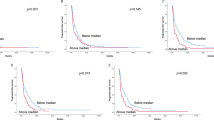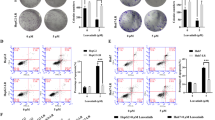Abstract
Elevated expression of NF-E2-related factor 2 (Nrf2), a nuclear transcription factor, is a frequent genetic abnormality seen in this malignancy and is an important contributor to chemoresistance in cancer therapy. In the present study, we investigated if Nrf2 was associated with drug resistance in tamoxifen-resistant MCF-7 (MCF-7/TAM) cells, and whether EGCG, major flavonoid isolated from green tea, could reverse drug resistance in MCF-7/TAM cells. Our results showed that the endogenous expression of Nrf2 as well as its target proteins heme oxygenase-1, NADP (H):quinone oxidoreductase in MCF-7/TAM cells was higher than that in MCF-7 cells. Epicatechin gallate (EGCG) significantly sensitizes MCF-7/TAM cells to tamoxifen and dramatically reduced Nrf2 expression at both the messenger RNA and protein, leading to a reduction of Nrf2-downstream genes. In addition, using siRNA technique, we found that the intracellular Nrf2 protein level was significantly decreased in MCF-7/TAM cells and tamoxifen resistance was partially reversed by Nrf2 siRNA. Combination of siRNA-directed gene silencing with EGCG downregulated the Nrf2-dependent response and partly reversed tamoxifen resistance in MCF-7/TAM cells in a synergic manner. These results suggested that combining the chemotherapeutic effect of EGCG with siRNA-mediated Nrf2 knock-down results in the feasibility of using Nrf2 inhibitors to increase efficacy of chemotherapeutic drugs.








Similar content being viewed by others
References
Sharma GN, Dave R, Sanadya J, Sharma P, Sharma KK (2010) Various types and management of breast cancer: an overview. J Adv Pharm Technol Res 1:109–126
Park SH, Ito K, Olcott W, Katsyv I, Halstead-Nussloch G, Irie HY (2015) PTK6 inhibition promotes apoptosis of Lapatinib-resistant Her2+ breast cancer cells by inducing Bim. Breast Cancer Res 17:86
Rose C, Thorpe SM, Andersen KW, Pedersen BV, Mouridsen HT, Blichert-Toft M, Rasmussen BB (1985) Beneficial effect of adjuvant tamoxifen therapy in primary breast cancer patients with high oestrogen receptor values. Lancet 1:16–19
Clemons M, Danson S, Howell A (2002) Tamoxifen (‘Nolvadex’): a review. Cancer Treat Rev 28:165–180
Jaramillo MC, Zhang DD (2013) The emerging role of the Nrf2-Keap1 signaling pathway in cancer. Genes Dev 27:2179
Osburn WO, Wakabayashi N, Misra V et al (2006) Nrf2 regulates an adaptive response protecting against oxidative damage following diquat-mediated formation of superoxide anion. Arch Biochem Biophys 454:7–15
Itoh K, Tong KI, Yamamoto M (2004) Molecular mechanism activating Nrf2-Keap1 pathway in regulation of adaptive response to electrophiles. Free Radic Biol Med 36:1208–1213
Vollrath V, Wielandt AM, Iruretagoyena M, Chianale J (2006) Role of Nrf2 in the regulation of the Mrp2 (ABCC2) gene. Biochem J 395:599–609
Jaiswal AK (2004) Nrf2 signaling in coordinated activation of antioxidant gene expression. Free Radic Biol Med 36:1199–1207
Lee JM, Johnson JA (2004) An important role of Nrf2-ARE pathway in the cellular defense mechanism. J Biochem Mol Biol 37:139–143
Baird L, Dinkova-Kostova AT (2011) The cytoprotective role of the Keap1-Nrf2 pathway. Arch Toxicol 85:241–272
Singh A, Boldin-Adamsky S, Thimmulappa RK, Rath SK et al (2008) RNAi-mediated silencing of nuclear factor erythroid-2-related factor 2 gene expression in non-small cell lung cancer inhibits tumor growth and increases efficacy of chemotherapy. Cancer Res 68:79757984
Zhang P, Singh A, Yegnasubramanian S, Esopi D et al (2010) Loss of Kelch-like ECH-associated protein 1 function in prostate cancer cells causes chemoresistance and radioresistance and promotes tumor growth. Mol Cancer Ther 9:336–346
Jiang T, Chen N, Zhao F, Wang XJ, Kong B, Zheng W, Zhang DD (2010) High levels of Nrf2 determine chemoresistance in type II endometrial cancer. Cancer Res 70:5486–5496
Akhdar H, Loyer P, Rauch C, Corlu A, Guillouzo A, Morel F (2009) Involvement of Nrf2 activation in resistance to 5-fluorouracil in human colon cancer HT-29 cells. Eur J Cancer 45:2219–2227
Kim SK, Yang JW, Kim MR et al (2008) Increased expression of Nrf2/ARE-dependent anti-oxidant proteins in tamoxifen-resistant breast cancer cells. Free Radic Biol Med 45:537–546
Boumendjel A, Di Pietro A, Dumontet C, Barron D (2002) Recent advances in the discovery of flavonoids and analogs with high-affinity binding to P-glycoprotein responsible for cancer cell multidrug resistance. Med Res Rev 22:512–529
Kandaswami C, Lee LT, Lee PP et al (2005) The antitumor activities of flavonoids. In Vivo 19:895–909
Yang CS, Prabhu S, Land J (2001) Prevention of carcinogenesis by tea polyphenols. Drug Metab Rev 33:237–253
Inoue M, Tajima K, Hirose K, Hamajima N, Takezaki T, Kuroishi T, Tominaga S (1998) Tea and coffee consumption and the risk of digestive tract cancers: data from a comparative case-referent study in Japan. Cancer Causes Control 9:209–216
Ji BT, Chow WH, Hsing AW, McLaughlin JK, Dai Q, Gao YT, Blot WJ, Fraumeni JF Jr (1997) Reduced risk of esophageal cancer associated with green tea consumption. Int J Cancer 70:255–258
Nakachi K, Suemasu K, Suga K, Takeo T, Imai K, Higashi Y (1998) Influence of drinking green tea on breast cancer malignancy among Japanese patients. Jpn J Cancer Res 89:254–261
Mukhtar H, Ahmad N (1999) Mechanism of cancer chemopreventive activity of green tea. Proc Soc Exp Biol Med 220:234–238
Katiyar SK, Agarwal R, Zaim MT, Mukhtar H (1993) Protection against N-nitrosodiethylamine and benzo[a]pyrene-induced forestomach and lung tumorigenesis in A/J mice by green tea. Carcinogenesis 14:849–855
Yamane T, Hagiwara N, Tateishi M, Akachi S, Kim M, Okuzumi J, Kitao Y, Inagake M, Kuwata K, Takahashi T (1991) Inhibition of azoxymethane-induced colon carcinogenesis in rat by green tea polyphenol fraction. Jpn J Cancer Res 82:1336–1339
Stuart EC, Scandlyn MJ, Rosengren RJ (2006) Role of epigallocatechin gallate (EGCG) in the treatment of breast and prostate cancer. Life Sci 79:232923–232936
Katiyar SK, Mukhtar H (1997) Inhibition of phorbol ester tumor promoter 12-O-tetradecanoylphorbol-13-acetate-caused inflammatory responses in SENCAR mouse skin by black tea polyphenols. Carcinogenesis 18:1911–1916
Kweon MH, Adhami VM, Lee JS, Mukhtar H (2006) Constitutive overexpression of Nrf2-dependent heme oxygenase-1 in A549 cells contributes to resistance to apoptosis induced by epigallocatechin 3-gallate. J Biol Chem 281:33761–33772
Gottardis MM, Jordan VC (1988) Development of tamoxifen-stimulated growth of MCF-7 tumors in athymic mice after long-term antiestrogen administration. Cancer Res 48:5183–5187
Choi HK, Yang JW, Roh SH, Han CY, Kang KW (2007) Induction of multidrug resistance associated protein 2 in tamoxifen-resistant breast cancer cells. Endocr Relat Cancer 14:293–303
Paglia DE, Valentine WN (1967) Studies on the quantitative and qualitative characterization of erythrocyte glutathione peroxidase. J Lab Clin Med 70:158–169
Kakkar P, Das B, Viswanathan PN (1984) A modified spectrophotometric assay of superoxide dismutase. Indian J Biochem Biophys 21:130–132
Draper HH, Hadley M (1990) Malondialdehyde determination as index of lipid peroxidation. Methods Enzymol 186:421–431
Chan JY, Kwong M (2000) Impaired expression of glutathione synthetic enzyme genes in mice with targeted deletion of the Nrf2 basic-leucine zipper protein. Biochim Biophys Acta 1517:19–26
Enomoto A, Itoh K, Nagayoshi E, Haruta J, Kimura T, O'Connor T, Harada T, Yamamoto M (2001) High sensitivity of Nrf2 knockout mice to acetaminophen hepatotoxicity associated with decreased expression of ARE regulated drug metabolizing enzymes and antioxidant genes. Toxicol Sci 59:169–177
Grandori C, Cowley SM, James LP, Eisenman RN (2000) The Myc/Max/Mad network and the transcriptional control of cell behavior. Annu Rev Cell Dev Biol 16:653–699
Fisher B, Redmond C, Legault-Poisson S, Dimitrov NV, Brown AM, Wickerham DL et al (1990) Postoperative chemotherapy and tamoxifen compared with tamoxifen alone in the treatment of positive-node breast cancer patients aged 50 years and older with tumors responsive to tamoxifen: results from the National Surgical Adjuvant Breast and Bowel Project B-16. J Clin Oncol 8:1005–1018
Duthie SJ, Melvin WT, Burke MD (1995) Drug toxicity mechanisms in human hepatoma HepG2 cells: cyclosporin A and tamoxifen. Xenobiotica 25:1151–1164
Gundimeda U, Chen ZH, Gopalakrishna R (1996) Tamoxifen modulates protein kinase C via oxidative stress in estrogen receptor-negative breast cancer cells. J Biol Chem 271:13504–13514
Khan N, Afaq F, Saleem M, Ahmad N, Mukhtar H (2006) Targeting multiple signaling pathways by green tea polyphenol (−)-epigallocatechin-3-gallate. Cancer Res 66:2500–2505
Novina CD, Murray MF, Dykxhoorn DM, Beresford PJ, Riess J, Lee SK, Collman RG, Lieberman J, Shankar P, Sharp PA (2002) siRNA-directed inhibition of HIV-1 infection. Nat Med 8:681–686
Gavrilov K, Saltzman WM (2012) Therapeutic siRNA: principles, challenges, and strategies. Yale J Biol Med 85:187–200
Berindan-Neagoe I, Cornelia B, Alexandru I (2012) Combining the chemotherapeutic effects of epigallocatechin 3-gallate with siRNA-mediated p53 knock-down results in synergic pro-apoptotic effects. Int J Nanomed 7:6035–6047
Wang XJ, Sun Z, Villeneuve NF et al (2008) Nrf2 enhances resistance of cancer cells to chemotherapeutic drugs, the dark side of Nrf2. Carcinogenesis 29:1235–1243
Ohnuma T, Matsumoto T, Itoi A, Kawana A, Nishiyama T, Ogura K, Hiratsuka A (2011) Enhanced sensitivity of A549 cells to the cytotoxic action of anticancer drugs via suppression of Nrf2 by procyanidins from Cinnamomi Cortex extract. Biochem Biophys Res Commun 413:623–629
Tang X, Wang H, Fan L, Wu X, Xin A, Ren H, Wang XJ (2011) Luteolin inhibits Nrf2 leading to negative regulation of the Nrf2/ARE pathway and sensitization of human lung carcinoma A549 cells to therapeutic drugs. Free Radic Biol Med 50:1599–1609
Ren D, Villeneuve NF, Jiang T, Wu T, Lau A, Toppin HA, Zhang DD (2011) Brusatol enhances the efficacy of chemotherapy by inhibiting the Nrf2-mediated defense mechanism. Proc Natl Acad Sci U S A 108:1433–1438
Hibasami H, Achiwa Y, Fujikawa T, Komiya T (1996) Induction of programmed cell death (apoptosis) in human lymphoid leukemia cells by catechin compounds. Anticancer Res 16:1943–1946
Paschka AG, Butler R, Young CY (1998) Induction of apoptosis in prostate cancer cell lines by the green tea component, (−)-epigallocatechin-3-gallate. Cancer Lett 130:1–7
Farabegoli F, Barbi C, Lambertini E, Piva R (2007) Epigallocatechin-3-gallate downregulates estrogen receptor alpha function in MCF-7 breast carcinoma cells. Cancer Detect Prev 31:499–504
Wang S, Chen R, Zhong Z, Shi Z, Chen M, Wang Y (2014) Epigallocatechin-3-gallate potentiates the effect of curcumin in inducing growth inhibition and apoptosis of resistant breast cancer cells. Am J Chin Med 42:1279–1300
Farabegoli F, Papi A, Bartolini G, Ostan R, Orlandi M (2010) Epigallocatechin-3-gallate downregulates Pg-P and BCRP in a tamoxifen resistant MCF-7 cell line. Phytomedicine 17:356–362
Acknowledgment
This work was financially supported by Iran National Science Foundation (INSF, grant number 92031220).
Conflict of interest
The authors declare that there are no conflicts of interest.
Author information
Authors and Affiliations
Corresponding author
Rights and permissions
About this article
Cite this article
Esmaeili, M.A. Combination of siRNA-directed gene silencing with epigallocatechin-3-gallate (EGCG) reverses drug resistance in human breast cancer cells. J Chem Biol 9, 41–52 (2016). https://doi.org/10.1007/s12154-015-0144-2
Received:
Accepted:
Published:
Issue Date:
DOI: https://doi.org/10.1007/s12154-015-0144-2




